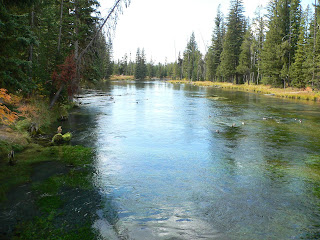Island Park is a mostly recreational area of Idaho. Technically it's a town, but it's 20 miles long and about a mile wide. Not many people live there year-round, as the snow pretty much cuts you off from everywhere. In the summer, it's a great place for recreation, though. Near to rivers and lakes and Yellowstone, as well as two state parks (Harriman and Henry's Lake), it's quite beautiful.
If you turn off by Mack's Inn, you will eventually (4 miles or so?) get to Big Springs, which is where the Henry's Fork of the Snake River starts. It starts suddenly, with a lot of spring water feeding it, and is full of very large trout. The water is clear and green plants grow in it.



A German immigrant named Johnny Sack built a cabin and mill up here. Obviously he was an adventurous sort, because if you live up here, you have to assume you'll be isolated for large stretches of time. Very nice when it's accessible, though!


If you take the Mesa Falls loop down towards Ashton (and civilization), you go through national forest land. Enjoy the rivers and wild animals (in this case, a musk rat)!


If you go down to the populated Snake River valley via highway 20 (ie, the normal route, as the Mesa Falls loop is not plowed in winter, and snow can cover the road by four feet), you'll pass Harriman State Park. It's the remains of a volcanic caldera, and is set up as a park to view wildlife. The endangered trumpeter swan lives here (yes, as in EB White's The Trumpet of the Swan).

Enjoy the river (whose source we saw above), the cattails on Silver Lake, and beautiful wasps' nests (but maybe don't touch!).
















































